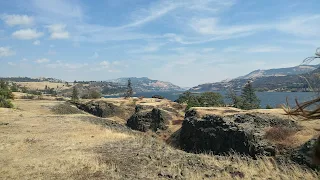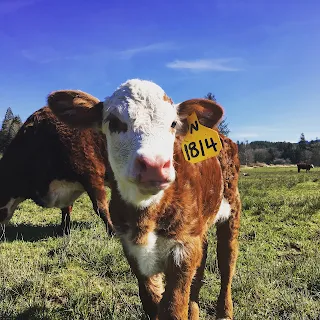And in my mind I still need a place to go
All my changes were there
- Neil Young, Helpless
Sometimes you can be connected to a place and returning to it can renew you.
My family immigrated to Washington state in 1978, packed into a Ford station wagon driving across the country from New Jersey.
I like to joke that my parents saw the movie “The Adventures of the Wilderness Family” one too many times.
The courses of our lives are guided by decisions and events much more complicated than that. Yet it would be futile to gather all the scraps for circumstance that led us from the suburbs of New Jersey -- sight unseen -- to the rugged architecture of the Columbia River Gorge.
To a nine year old boy, our family expedition from “flat land and brown air” in the Spring of that year seemed like an endless summer vacation.
 |
| Our farm in Lyle as it looked when we first moved there in 1978. |
Salamanders in the spring house, hidden fields and arrowheads, horseback rides along the windswept bluffs to abandoned farmsteads, evening walks with my father to the top of the hill to count the pink mountains almost close enough to touch.
When you are a child, you experience joy often, and appreciate it only rarely.
Each year I bring my family back to the little town in the Columbia River gorge where I grew from a child to a man.
Even though I lived nine years on the East Coast before we moved there, I always say I “grew up” in this place. I only lived there for a dozen years. I have long since grown much deeper roots in the rainshadow green of the Grays River Valley.
Yet the rings on my tree are etched deeper and wider in those Gorge years somehow. The decade between nine and 19 is packed with so many changes -- including how we come to understand the world as something greater than our own experience -- we cannot help but be changed by it. As much rambling joy and adventure I had in the hills around Lyle, Washington, I experienced just as much fear, awkwardness and embarrassment and alienation. Yet that has faded over time, wounds have healed and joy remains.
It comes back to me on the August wind.
We started a tradition -- I don’t know how it came to be -- of having our picture taken in a certain spot along the Klickitat river. We’ve been coming to this place since Lindsay was in diapers. This year she is a senior in high school.
The waters of the Klickitat are fed from the glaciers of the mountains. Each year I dip my hat in the cold water and place it on my head, rebaptizing myself in the moment of geologic suspension.
I can flip though the old photographs and see our changes. The river is sometimes lower, sometimes higher, forcing us to climb a bit more up onto the rocks. Yet, the hills are ageless against our microscopic timelines. Years are seconds to them, too numerous to bother with counting.
Once upon a time I rode my horse through these hills and knew the trails without name. Once upon a time, my sister taught me to drive along these backroads. Here was the old junkyard where my little league baseball coach lived, here the school bus would stop to the let the trains go by.
Gone now gone. Gone to a memory that has to hold on to rails to steady itself until it gets its bearings.
On a basalt plateau above the Columbia River hides a curling trail that dives into the scrub oak and yellow grass and dares the great cliffs that judge the changes in the windswept white-capped waters. Catherine Creek is a little preserve that was first set aside the year I graduated high school. Before that we called this place “rattlesnake flats” or graydigger flats because flattened fauna that littered the asphalt of the long straight of lonely road.
My father moved back to New Jersey after just five years in the Gorge -- in some ways, against his will. Life had other plans for him.
Yet each time he comes out to visit, he brings his wife and kids and grandkids to Kathrine Creek, to hike among the wildflowers on the windy cliffs.
Until this year, I had never stopped.
When I stopped, I understood.
For in our experience, this place preserves the distilled essence of the Gorge I remember, before the wineries and windsurfers. Yellow grass clings to lichen-pocked basalt, while wildflowers grow in the cracks of the rocks or the shade of huddled scrub oak. Wind on endless warm wind braces you.
When you live in the Gorge, the wind becomes a part of the landscape such that you don’t notice it -- ever present in every August afternoon.
We take our childhoods for granted, they are so often a mix of unmet expectations, underappreciated joys and careless dreams. The summers of our lives can seem so busy that even a lazy day in a hammock can need a week’s worth of planning.
August - particularly in window of time after the fair and before the start of school -- we try to squeeze a lot of adventures into the little time we have left.
“Carpe Summer” I say -- a crude variation of Carpe Diem - latin for seize the day.”
September will be no less busy. Yet, it has a different tone and rhythm. The rains will come as early as October, and there is much around the house that needs to be done. I can sense the change each year on the drive back from the Gorge. Sun sets earlier, the mornings have chill. Early fallen leafs swirl along the side of the road.
You can feel the end of summer looming, but still, but still.
The Septembers of our lives come with a suddenness that staggers. So much still to be done before winter sets in.
It is important to touch base even now and again, to take a quiet moment in a wild place of our younger selves -- to appreciate all the days that have been given to us as well as to marvel at our survival thus far.

















